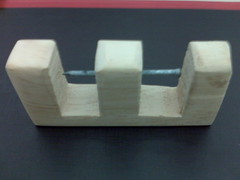The idea of this puzzle is to work out how the oject GOT INTO the wood - NOT how to get it out again. Once you know how it got in, the process can be reversed and only then you can get it out again without breaking it!
- The wood is not cut and joined and remains in one piece throughout the process.
- The wood is not steamed, bent or twisted
- The pencile, screw or nail is not cut and joined
- Lateral thinking involved - use your brain, not brute force
- Fascinate your friends; frustrate your foes!
- Many people have had a theory - engineers, mechanics, scientists, carpenters and woodtrners... BUT few have solve the mystery!
Post your solutions, since I am clueless...
(C) on puzzle by A Touch of Craft, Mole Creek, Tasmania, Australia
More photos of the puzzle....
And a link about the creator of this puzzle.


5 comments:
basically you have to boil one end of it in water for 10 mintes and then squash it in a vice.
see here
http://www.woodworkforums.ubeaut.com.au/showthread.php?t=44003&page=6
Pic 1: Boil for 10 minutes. The duct tape guy straps keep the block from falling over.
Pic 2: Squeeze in a vise. Note severe distortion of the tooth.
Pic 3: Drill the second tooth. I waited only one day; this was sufficient for my timber. My drilling was slightly tilted. Normally, I'm more accurate than this. I attribute the shortcoming to the enthusiasm of the chase.
Pic 4: Insert pencil.
here's the url again
woodwork forums
the 'joe greiner' method
Mole Creek Wood Puzzle.
Here is a possible solution that might give you at least some peace from the torment of this little monster. I hope I'm wrong and don't spoil the legend but this puzzle like all puzzles will eventually be solved by someone one day i guess,if there is a solution, besides i cant resist a challenge. Its only an idea but quite a few things click and there is some evidence to support it.
My logic goes:
1.The task is cryptic and open to interpretation.
2.The puzzle aspect of it is only a distraction, like magic tricks they rely on distractions.
3. You basically cant drill a hole without an entry point, its impossible.
4. Look not only in 3 dimensions but also consider the effects of time on matter. Lateral thinking.
5. the enigma was perhaps encountered by mistake perhaps 30 or 40 years ago, the puzzle was built around the chance discovery which was easy to solve in its correct context. What you see now is simply out of context.
Here goes:
He has fast growing pine trees, when they are only 6 inches in diameter he drills horizontal holes and seeds the objects. 10 years later the tree is 26 inches in diameter and the hole/object has 10 inches of undrilled wood either side of the hole/object. In effect a time capsule. If he uses an object with a head,the head is simply counter sunk and the gap in the puzzle conceals the larger hole, makes it look like its all one diameter. He can drill with a jig from the inside out as long as he leaves a couple of inches of undrilled on the outside. He can place hundreds of objects in one tree, and seed many trees. As he harvests the trees he seeds some new ones to replace the old ones. In effect a renewable crop, a continual cycle, the legend lives on.
The cryptic solution:
he gets the object into the wood(tree) by seeding. He gets the object out of the wood(tree), not the puzzle,by the reverse process of harvesting. The form of the puzzle as you see it now is simply a distraction or a novel way, of displaying the unbroken harvested object, some what like the way a palaeontologist would extract and display a fossil, but the palaeontologist goes out of his way to display the fossil in context relative to the sedimentary rock that hosts it.
To do this Mr Mole Creek simply maps with markers where the objects are located then harvests them.He slices the trees perpendicular to the long axis of the tree like slicing carrot rings rather than carrot dip sticks.
The evidence- I think? A wood carver or carpenter will be able to confirm or dismiss this. Most working timber is sliced parallel to the long axis of the tree for structural purposes. To me the grain of the timber suggests a carrot ring type cut rather than a plank type cut of timber has been used in at least the photo i saw of this puzzle.
Even if this is not the answer in my mind the torment is gone, at least i have something to trick my mind into moving on!
Alan
I believe that everyone is looking at it from the wrong perspective = the wood. Try looking at the nail, May be the nail is not actually in one piece, there seems to be enough room to insert two half nails into the centre section of the puzzle. :)
It said not to steam it..... dumb. We figured it out in 30 seconds but assumed they wouldny lie in the instructions. Shoddy puzzle.
Post a Comment